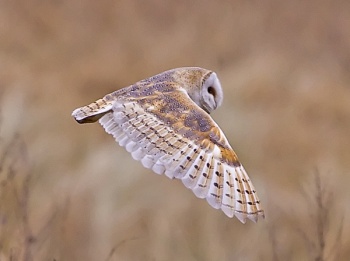- Tyto alba
Identification
It is 29–44 cm (11½-17¼ in) in length, with an 80–95 cm wingspan. A pale, long-winged, long-legged owl with a white, heart-shaped face. The head and upperparts are buff, and the underparts vary from white to chestnut, depending on subspecies.
Variation
Nominate alba from Western and Southern Europe and the Western Canary Islands is pale above and white below, while guttata from Central and Eastern Europe (has also been recorded from Britain) is much greyer above and buff to chestnut below.
T. a. ernesti from Corsica and Sardinia resembles alba but is even paler above as is the large race erlangeri from North Africa, Arabia, Crete and Cyprus which also differs in its bare tarsi and toes.
The main African race, affinis intergrades with erlangeri in southern Egypt and resembles guttata but is larger with deeper colouration and more heavily marked upperparts.
The Madeiran race schmitzi resembles affinis but is smaller with more distinctly spotted and darker underparts, gracilirostris from Fuerteventura, Lanzarote and Allegranza in the eastern Canary Islands is very similar but even darker below and has more slender bill and legs.
Confined to Cape Verde Islands is the race detorta, like guttata but deeper orange below and more distinctly spotted above with thinly feathered legs.
Distribution
Widespread in Europe and Africa but in decline in many areas due to changes in farming practices.
Breeds in the British Isles (except the north), Iberia and France east to the Black Sea and north to the southern shores of the Baltic. In the south found along the north Mediterranean coast east to the Adriatic but very patchy in Greece, also on all major islands including Crete and Cyprus. Rare and local in Israel, Syria and Iraq. In north Africa breeds in Morocco, northern Algeria and Tunisia, also on the Egyptian coast and in the Nile Delta and Valley. Also breeds on Madeira, the Canary Islands and Cape Verde Islands.
All populations are resident but there is some dispersal of juveniles and vagrants have occurred in Jan Mayen, Norway, Finland and Estonia, also on the Azores.
In Africa is found almost uniformly but missing from deserts and the most humid tropical rainforest in the Congo bassin.
Taxonomy
One of three species formerly considered one under the name of Barn Owl.
Subspecies
Clements recognizes these subspecies[1]:
- T. a. alba: West and southern Europe; western Canary Islands and North Africa
- T. a. guttata: central Europe eastward to Latvia, Lithuania, and Ukraine, and southeastward to Albania, Macedonia, Romania, and northeastern Greece
- T. a. ernesti: Corsica and Sardinia
- T. a. erlangeri: Crete and Cyprus to south west Iran, north east Egypt and southern Arabian Peninsula
- T. a. schmitzi: Madeira and Porto Santo Island
- T. a. gracilirostris: Eastern Canary Islands (Fuerteventura, Lanzarote and Alegranza)
- T. a. poensis: Sub-Saharan Africa (including Bioko, Zanzibar, and Pemba), the Comoro Islands and Madagascar
- T. a. detorta: Cape Verde Islands
- T. a. thomensis: São Tomé (Gulf of Guinea)
The last two subspecies have been proposed as two full species[3].
Habitat
Open country with some trees or rocky outcrops for nesting. In Europe now found mainly on farmland with copses, areas of rough grassland and hedgerows. Often nest in old farm buildings, churches and ruins.
Behaviour
Diet
The diet includes small mammals, particularly rodents, and is supplemented with other small vertebrate (such as birds and lizards) and large invertebrate life. A couple of examples: In Denmark, the local Barn Owls seems to strongly rely on Screws which are found in wet fields and marshes.
Breeding
Typical nest sites include buildings, tree stumps and cliff crevices; Barn Owls will readily use appropriately designed nest boxes. The clutch of 4-7 eggs are incubated for 33 days. The male helps feed the young and the chicks can fly after 9-12 weeks.
Flight
Hunting flight is typically low gliding over fields and hedgerows with intermittent fast, low flapping ranging flight with a banking stoop with spread wings onto prey. Hunts day or night, though mainly nocturnal. There seems to be a lot of variation in this between different individuals. This makes monitoring populations problematical.
Vocalisation
References
- Clements, J. F., P. C. Rasmussen, T. S. Schulenberg, M. J. Iliff, T. A. Fredericks, J. A. Gerbracht, D. Lepage, A. Spencer, S. M. Billerman, B. L. Sullivan, M. Smith, and C. L. Wood. 2024. The eBird/Clements checklist of Birds of the World: v2024. Downloaded from https://www.birds.cornell.edu/clementschecklist/download/
- Gill, F, D Donsker, and P Rasmussen (Eds). 2024. IOC World Bird List (v 15.1). Doi 10.14344/IOC.ML.15.1. http://www.worldbirdnames.org/
- König, C. and F. Weick 2008. Owls of the World, second edition. Christopher Helm, London. ISBN 978-0-7136-6548-2
- Eaton, JA, B van Balen, NW Brickle, FE Rheindt 2021. Birds of the Indonesian Archipelago (Greater Sundas and Wallacea), Second Edition. Lynx Editions. ISBN978-84-16728-44-2
Recommended Citation
- BirdForum Opus contributors. (2025) Western Barn Owl. In: BirdForum, the forum for wild birds and birding. Retrieved 12 May 2025 from https://www.birdforum.net/opus/Western_Barn_Owl
External Links
GSearch checked for 2020 platform.1





